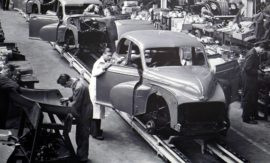Intended learning outcomes: Describe different means used for cooperation between the R&D and the order-specific engineering departments. Present the portfolio of cooperation types between R&D and engineering in ETO companies.
Mass customization is widely used in sectors such as construction, machinery and equipment, automotive and fashion. The “standard” product solution space is ultimately determined by the R&D department, as a part of the product design (PD) process, by determining the parameterization. The Engineering department (generally separate from the R&D department) sets up the order specific engineering (OSE) process, which covers all the design activities aimed at a specific customer order. This process should extend the product solution space quickly and efficiently so that it can cater for non-standard requirements.
A lack of cooperation between the R&D and Engineering departments in companies is one possible cause for delays and cost overruns. Engineer-to-order (ETO) firms have to find ways to quickly adapt and integrate engineering, manufacturing and supplier capacities. In practice, however, there are significant differences in cooperation between the R&D and Engineering departments. [SöWe17] addresses these differences in firms in the construction and machinery industries. Section 7.5.1 summarizes the observations in the case of two companies — details about the various means (practices and tools) used can be found in [SöWe17]. Section 7.5.2 identifies factors that influence the cooperation and thus the choice of such means. From this, it develops a portfolio with four sectors of fundamental types of cooperation in ETO firms. Companies in the same sector can benefit from sharing their methods and tools.
Course section 7.5: Subsections and their intended learning outcomes

7.5 Cooperation between R&D and Engineering in ETO Companies
Intended learning outcomes: Describe different means used for cooperation between the R&D and the order-specific engineering departments. Present the portfolio of cooperation types between R&D and engineering in ETO companies.

7.5.1 Different Means Used for Cooperation between the R&D and the Order-specific Engineering Departments
Intended learning outcomes: Present in detail design and specification of a product in an ETO environment as five phases of potential cooperation between R&D and Engineering along the value chain. Explain the ETO businesses of industrial steam turbines and high-rise elevators.

7.5.2 Two Fundamental Cooperation Types in ETO Companies
Intended learning outcomes: Identify influencing factors of cooperation between R&D and Engineering. Disclose two fundamental cooperation types in ETO companies.

7.5.2b The Portfolio of Cooperation Types between R&D and Engineering in ETO Companies
Intended learning outcomes: Explain the portfolio of cooperation types between R&D and Engineering in ETO companies.
Course 7: Sections and their intended learning outcomes

Course 7 – The Concept for Product Families and One-of-a-Kind Production
Intended learning outcomes: Produce logistics characteristics of a product variety concept. Explain adaptive and generative techniques in detail. Describe the use of generative and adaptive techniques for engineer-to-order. Differentiate various ways of cooperation between R&D and Engineering in ETO Companies.

7.1 Logistics Characteristics of a Product Variety Concept
Intended learning outcomes: Differentiate between high-variety and low-variety manufacturing. Describe different variant-oriented techniques, and the final assembly schedule.

7.2 Adaptive Techniques
Intended learning outcomes: Explain techniques for standard products with few variants as well as techniques for product families.

7.3 Generative Techniques
Intended learning outcomes: Disclose the combinatorial aspect and the problem of redundant data. Present variants in bills of material and routing sheets as production rules of a knowledge-based system. Explain the use of production rules in order processing.

7.4 Generative and Adaptive Techniques for Engineer-to-Order (ETO)
Intended learning outcomes: Differentiate between the classical procedure and different archetypes of engineer-to-order. Describe the approach for basic and for repeatable engineer-to-order.

7.5 Cooperation between R&D and Engineering in ETO Companies
Intended learning outcomes: Describe different means used for cooperation between the R&D and the order-specific engineering departments. Present the portfolio of cooperation types between R&D and engineering in ETO companies.

7.6 Summary
.

7.7 Keywords
.

7.8 Scenarios and Exercises
Intended learning outcomes: Apply adaptive techniques for product families. Disclose the use of production rules in order processing. Elaborate the setting the parameters of a product family.
